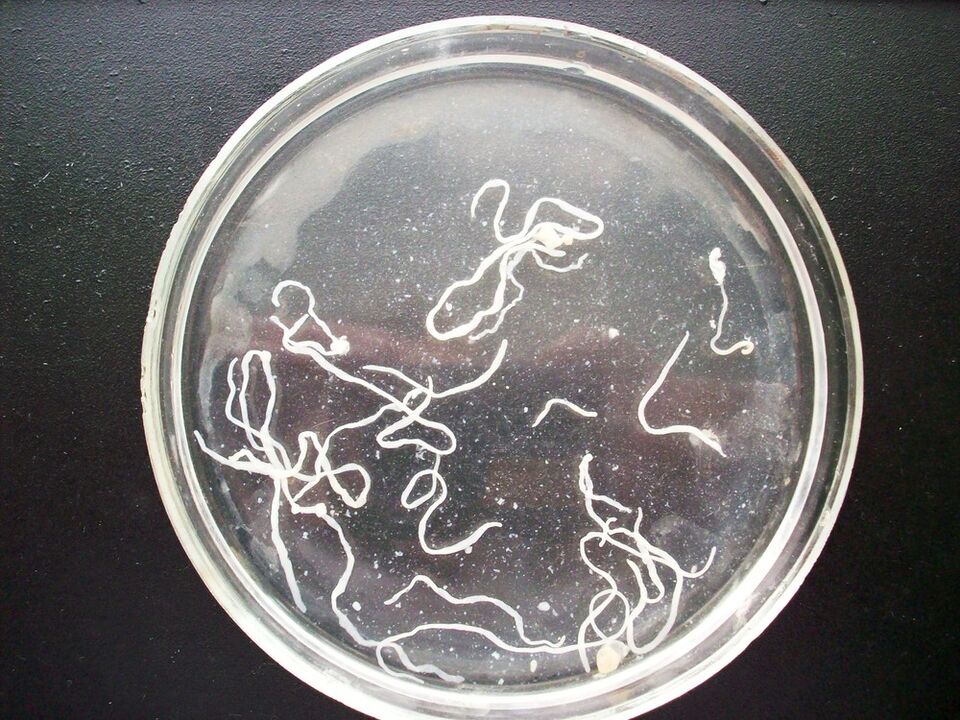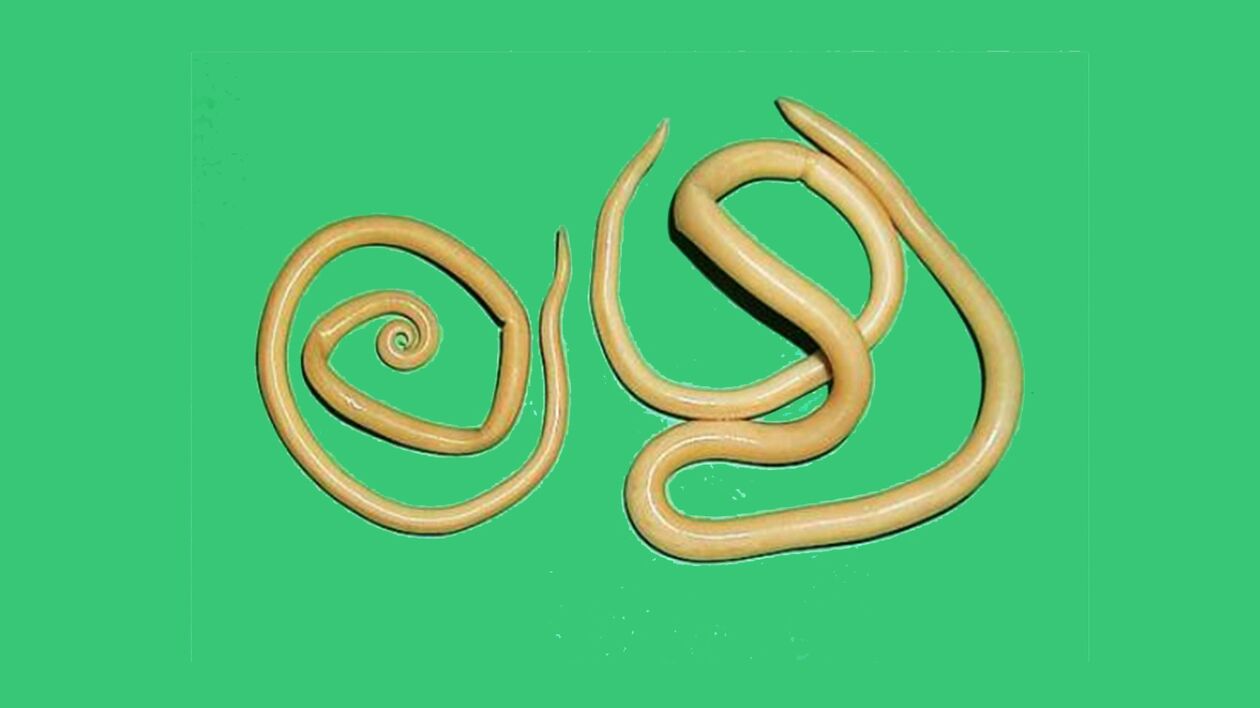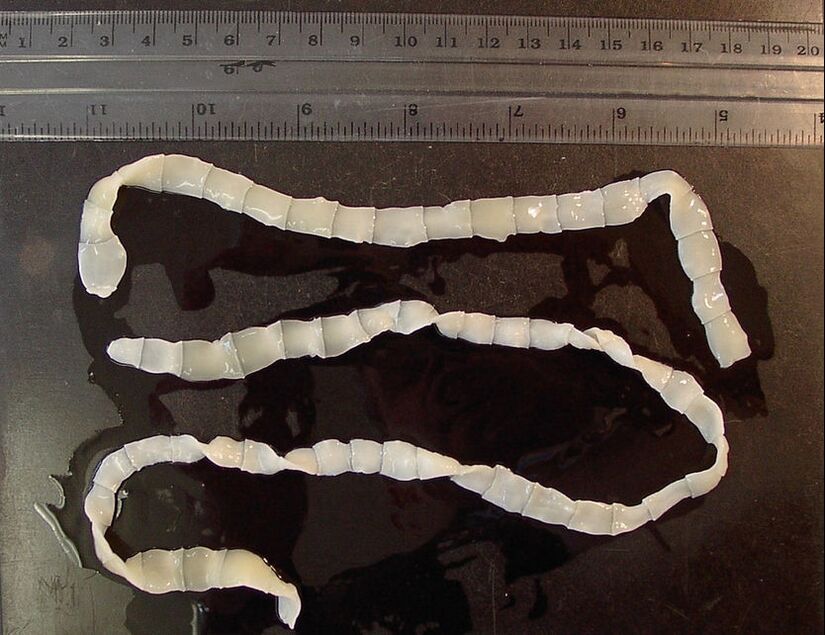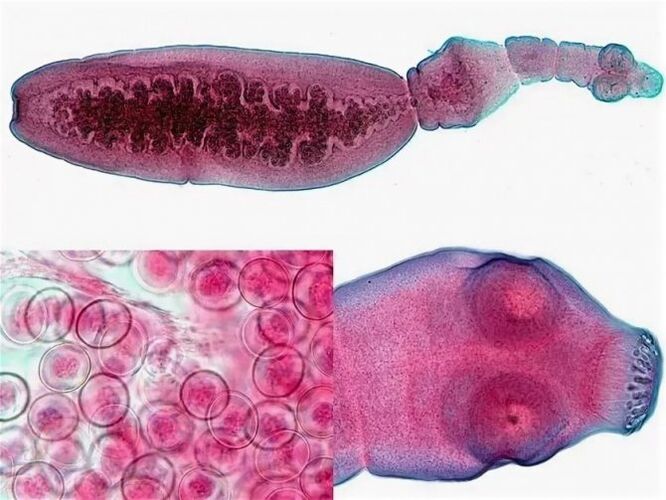
Pinwormis a frequent guest in children's groups. It is a medium-sized (up to 1 cm in length) inhabitant of the small and large intestines, leaving the rectum and laying eggs, in skin folds, underwear and bedding. It occurs more often at night and is accompanied by severe itching in the anus. Pinworm eggs mature after 4-6 hours and are ready to cause disease, perfectly protected in the environment. They enter the human body through dust, dirty hands, soft toys, underwear and dishes.
Diagnosis - itching of the skin around the anus and examination under a microscope, at least 3 times at intervals of 3 days.
When pinworm eggs are found, the whole family of infected people should be tested.
Approximately 350 million people worldwide are infected with enterobiosis, and when one family member becomes infected, the risk of the disease to all families is very high.
Toxocara is a parasite
Toxocarais a parasite in the digestive system of dogs. In the United States and Europe, 80% of puppies and more than 50% of adult dogs have toxocariasis. Human studies have shown that up to 37% of the population is sensitive to the Toxocara antigen. This means that these people were or still are carriers of toxocara.
Toxocara is up to 30 cm long, in this form it lives in the body of its permanent owner - the dog. The dog lays toxocar eggs in the sand, which can last for several years. They fall into the hands of children playing with sand, sandboxes, and at the same time cling to shoes and clothes. Entering a human is a dead point for the parasite, as the larvae grow and spread between the blood vessels and internal organs, but are not visible.
Fecal analysis is generally not informative, but requires biopsy of the affected organs (usually the liver) and immunological tests to make a diagnosis.
The saddest thing is that toxocara slides into the eyes (15% of eye drops in the world are caused by toxocara), and damage to the lungs, heart, brain, and muscles is also unpleasant - fever, cough, liver enlargement, lymph node inflammation, skin rash, skin rash, convulsions.
Ascaris - parasite

Ascarisaffects about 100 million people a year. It enters a person with raw water, dirty hands, food with dust (usually uncooked herbs, vegetables and fruits) and is actively carried by flies. The roundworm is up to 40 cm long, and every day a female roundworm lays up to 200, 000 eggs, which enter the soil and are well protected for years. The swallowed worm egg turns into a larva in the small intestine, then penetrates the intestinal wall, enters the blood capillaries, and is carried to the liver, brain, eyes, heart, and lungs. In the process of movement, roundworms feed on blood - erythrocytes and nutrients. Anemia (anemia) is often a companion of ascariasis.
Migration of larvae in humans causes allergies, pain all over the body, fever, asthma, arthritis, neurodermatitis, eczema, the risk of seizures. If blood enters the lungs due to rupture of blood vessels, bleeding and hemoptysis are possible on X-rays - infiltrates, as in the case of tuberculosis.
Sputum roundworms travel along the bronchi to the pharynx and enter the mouth, then the esophagus, stomach and intestines. Roundworms are caught in the gut, resting on the intestinal wall, causing inflammation, infiltration and bleeding. Complications are possible when the roundworm enters the nasal sinuses, liver, bile ducts, pancreas and kidneys. There are intestinal obstruction, purulent processes in the abdomen. Diagnosis is based on fecal analysis (at least 3 times), immunological tests - larval cycle.
Hookworm is a parasite
Hookworm- can enter a person through the skin when walking barefoot (leaves no trace), as well as through the mouth like a roundworm. Hook worm size - up to 1. 5 cm, migrates and damages in the same way as a round worm. The feature is a symptom such as itchy rash on the limbs and more pronounced anemia.
As in most seizures, stool tests should be performed at least 3 times.
Wide band - parasite

A broad-leaved wormis a large long liver,an individual up to 10 meters long and living in the human body for up to 25 years.Can you imagine what happens to a person if there are several such great centuries inside?
Think of how the worm is wrapped in the gut, leaving little space in the lumen of the human gut! If the worm were "corrected", it would hang half its length! By the way, the worm absorbs all the necessary and useful substances for itself from all over the body.
You can be infected by eating raw, well-salted fish, crustaceans and caviar. Symptoms of a tapeworm may include anemia, exhaustion, abdominal pain, especially in the morning, increased salivation, vomiting, nausea, weakness, lethargy, drowsiness. Intestinal obstruction is possible.
The unprepared person is completely surprised by the release of the parasite's severed "tail" from the intestine - a feature of tapeworms that helps diagnose.
Beef and pork worms are parasites
Beef and pork worms are parasites that enter the human body through raw meat, meat products, and lard.
An adult wolf worm is up to 7 meters long, a pig worm is up to 2 meters long, has a lifespan of up to 20 years, and is the main threat to larvae. to penetrate the eyes and brain.
Echinococcus and Alveococcus - parasites

Echinococcus and alveococcus are parasites that a person infects as a result of contact with animal carriers, drinking contaminated water, and swallowing soil with berries and vegetables.
Larvae from the gut enter the liver, lungs, kidneys, bones and brain and are carried by bloodstream to all parts of the body. The larva develops into a growing cyst by squeezing the surrounding tissues. Symptoms depend on the location of the cyst and the degree of compression of the organs.
Fracture of a cyst is a very serious complication.
Giardia - parasite
Giardiais the simplest parasitic animal of the flagship class. Pear-shaped, 10-20 microns long; the dorsal side is convex, the ventral side is concave, and the host forms a suction cup to temporarily close the intestinal epithelial cells. 2 oval nuclei, 4 pairs of flagella. It lives in the human intestine (mainly in children), mainly in the duodenum, less in the bile duct and gallbladder, and causes nyardasia. Asymptomatic parasitic carriers are very common. Infection with cysts, protozoa when contaminated food or water enters the body through the mouth into the lower intestine, as well as from dirty hands, etc. Incidents happen from time to time. Giardiasis is common all over the world.




































